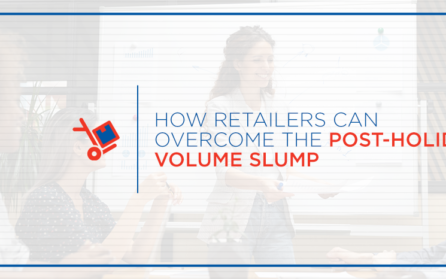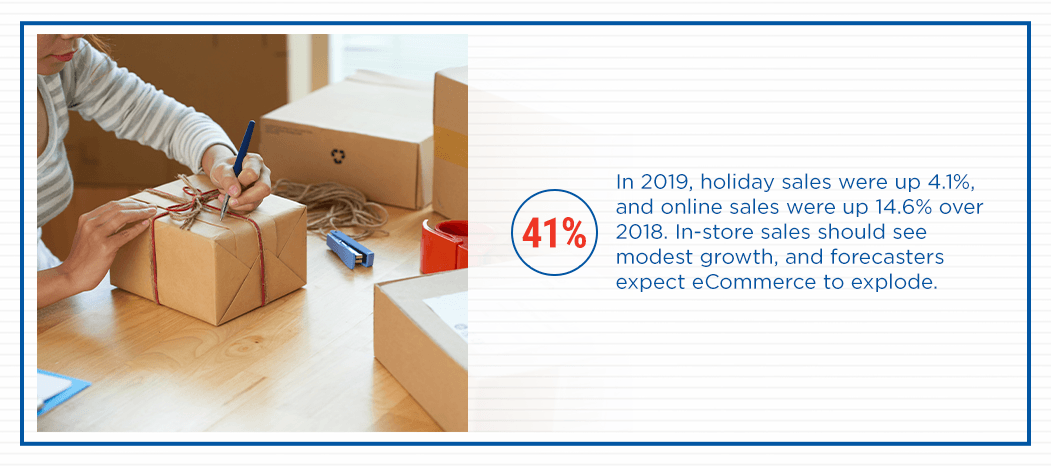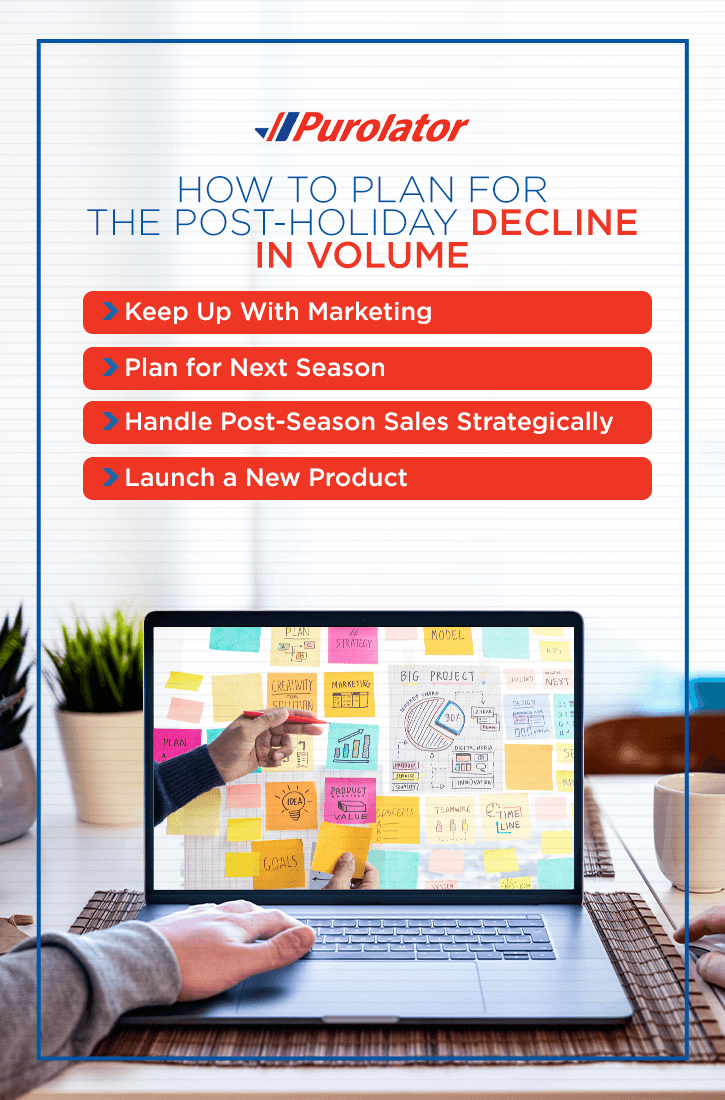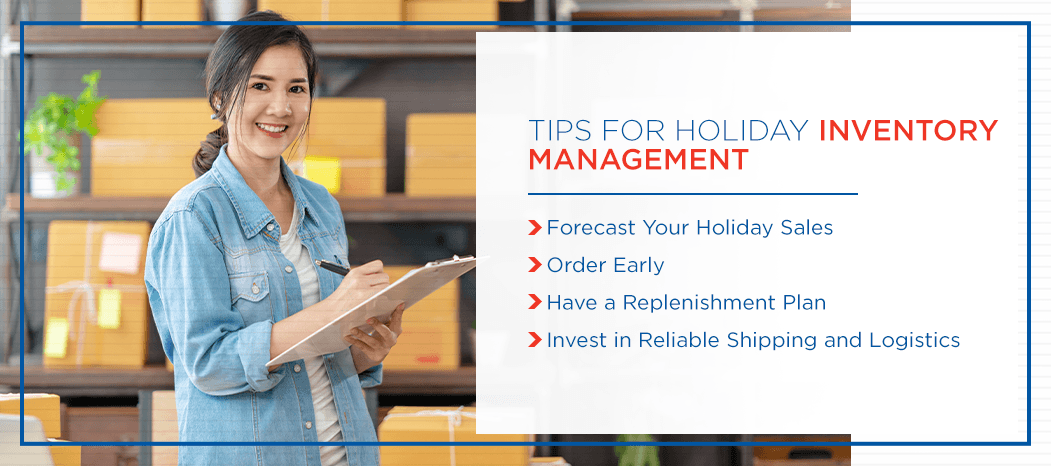Blog
How Retailers Can Overcome the Post-Holiday Volume Slump

Business-to-consumer retailers — brick-and-mortar and eCommerce sellers alike — rely on the holiday season to bookend their sales year with a positive outcome. The economy can be unpredictable, so ending the year strong as shoppers plan their holiday gifts is crucial. Retailers expect to see a significant bump in sales during the holiday season. Just as likely is a post-holiday decline in sales. We’ve compiled some forecasts for what to anticipate this holiday season. We also included a list of the best ways to plan for the post-holiday decline — and the initial holiday rush.
What to Expect in the Holiday and Post-Holiday Season
Year after year, physical retail sales tell the same story. First, sales go up. Then, they go back down. ECommerce follows a similar pattern. For 2020, the increase and decrease may look a little steeper. ECommerce sales are expected to spike as more people choose to shop from home. However, challenging economic times may force consumers to limit their spending more than usual during the post-holiday season.

The Retail Holiday Shipping Surplus
In 2019, holiday sales were up 4.1%, and online sales were up 14.6% over 2018. In-store sales should see modest growth, and forecasters expect eCommerce to explode. One forecast expects online retail sales to grow by 18.5%.
ECommerce stores in popular gifting categories will enjoy a particularly favorable sales bump. Home furnishings should see a 16% increase, while experts expect fashion to grow 19%. Consumer electronics should rise 20%, and health and beauty could increase by 23%. Anywhere from 42%-62% of consumers plan to do all their holiday shopping online this year.
The November and December shopping season has always rewarded retailers with a huge sales boost. This year, sales spikes have trickled into October. Many physical retailers are choosing to convert their locations into fulfillment centers for online and curbside pickup sales. As more major retailers transition into eCommerce, they’ve pushed earlier sales as a way to get ahead of the expected shipping surplus. Some have even dubbed October sales as “early Black Friday” events.
Recent eCommerce booms have already placed a strain on last-mile logistics. Retail holiday shipping planning is more critical this year. Without planning, eCommerce stores risk late deliveries. If those packages don’t arrive in time for the holidays, retailers will face an ensuing wave of returns. In-person retailers can face stock-outs that limit their sales during the most competitive time of the year. Staying ahead of the upcoming holiday shipping surplus requires an air-tight supply chain. This year especially, working with reliable and fast transportation providers is crucial.
The Volume Decline Post-Holidays
Once all the gifts have been opened and the holidays die down, shoppers tend to be a lot thriftier. They’ve just bought or received many big-ticket items and may feel less inclined to go shopping. Consumers spend more during the holidays than at any other time of year, which means sales tend to dip in January.
In 2020, the average consumer planned to spend $196.31 for Valentine’s Day, which is right around the corner come January. With this month sandwiched between two of the year’s top spending events, many consumers tighten their wallets. After seeing the numbers on their December credit card statements, 51% of Americans resolved to manage their finances better in the new year. A dip in sales at the start of the year is inevitable. In 2018, retailers suffered a 0.3% sales decline in January.
For eCommerce retailers, the surplus inventory they’ve kept to avoid holiday stock-outs will sit in the warehouse, unmoved. It’s crucial to manage the lowered shipping and activity volume to move unsold stock efficiently.
How to Plan for the Post-Holiday Decline in Volume
Preparing for the incoming wave of online orders is probably a lot more exciting than planning for the impending drop in sales. How do you plan for the post-holiday sales decline? While combating the decrease in volume is a challenge, it’s more than doable. Around 48% of consumers in 2019 stated they had an interest in pursuing post-holiday sales. Offsetting the sales dip is crucial to avoid setting yourself back after bringing in all your holiday revenue. Here are four ways to overcome the post-holiday volume decline:
1. Keep Up With Marketing
After a busy year-end and working tirelessly to keep up with competitors and last-minute sales, many eCommerce marketers take a break in January. They have achieved incredible reach and sales lift during the holidays, and the post-season feels like a time to kick back and celebrate. Besides, consumers have seen thousands of ads for the last few months and could be experiencing marketing fatigue.
As many of your competitors slow down, the post-holiday season is the perfect occasion to pick up new campaigns and find new, creative ways to market. Put all those emails collected from first-time buyers to use and engage your audience. Offer tips for using the products they just bought and send customized offers based on recent sales and abandoned cart data. It’s the perfect time to launch a new loyalty program or refresh your brand.
2. Plan for Next Season
After the holidays are over, upcoming shopping events include Valentine’s Day, the Super Bowl and St. Patrick’s Day. If any of your usual inventory applies to one of these events, start marketing deals themed around your upcoming shopping holidays. Whether you’re an eCommerce store or a physical retailer, start stocking up on new event items.
Even though spring feels like a long way off, it’s a great time to get shoppers excited about next season. They’ve bought many of their winter seasonal items already, so the post-holiday is a fantastic time to stock up on spring supplies. Offer early bird deals on outdoor and spring items. Capitalize on shoppers’ desire for warmer weather before other retailers have jumped on board.
3. Handle Post-Season Sales Strategically
Many retailers use the post-holidays as a season for deep discounts. They’re hoping to clear out excess holiday inventory and offset the January sales decline. One way this strategy can backfire is by triggering buyers’ remorse. If shoppers see a massive discount on items they just bought for full price, prepare for complaints, returns and refunds.
To dodge this pitfall, focus on personalizing your offers. If you need to offer a 60% discount on a popular item to clear out inventory, consider making it an exclusive deal available to new customers only. Use careful targeting and retargeting to prevent showing this deal to existing customers. Analyze your sales data when constructing deals for those who shopped with you during the holidays. If they just bought one item, offer discounts on the complementary items. For example, those who purchased a laptop might enjoy accessories such as protective cases or earbuds.
4. Launch a New Product
Another way to boost revenue without setting off returns is to launch a brand new product. This strategy is perfect for the new year because it fits right in with the spirit of the season. Think “new year, new you” promotions, where you highlight your new offering as a way your brand is transforming itself this year.
A new product launch can attract existing customers and new customers alike to boost your January sales. Current customers won’t feel left out of a blowout deal on a product they already own. And new customers could discover your brand for the first time thanks to the launch.
Launching a new product post-holidays works especially well for small businesses. It won’t be overshadowed by the onslaught of new products released before the holidays. Capitalize on the early-adopters in your customer base and their fear of missing out (FOMO) in January.
Tips for Holiday Inventory Management
The initial uptick in volume can be challenging to manage without proper planning. Missing out on sales due to lack of inventory or shipping delays can put a damper on a shopping season destined to produce record online sales. How can you maximize inventory before the holidays? Make the most of the projected sales season by following these tips:
1. Forecast Your Holiday Sales
Predicting your sales and shipping demand will depend on several factors. Look at your sales reports from the previous holiday season, and compare it to your current sales velocity as this year’s holiday season picks up. Look at some in-depth analysis and projections in your sector to compare to your data.
Whatever you can reasonably expect to sell each week or each month should be the minimum amount of inventory you keep between restocks. Be sure to factor in some extra safety stock to account for any supplier delays that could get amplified this year due to increased eCommerce demand. Despite forecasters’ best efforts, 2020 has remained unpredictable. Some extra stock will come in handy if you experience a sales volume beyond your predictions.
2. Order Early
The increase in eCommerce sales has caused many suppliers to slip behind demand. At the same time, transportation vendors are placing higher premiums on fast shipping. Get ahead of these potential delays by placing inventory orders early. Stock up on trendy items even earlier.
3. Have a Replenishment Plan
Getting products to customers quickly and an uptick in volume will likely cause increased inventory turnover. You need to ensure a steady supply of inventory can get to your warehouse in time to replace the regular volume of product shipping out. Again, this demand requires early reordering. Ensure you’re sending reorder requests in time to account for your vendors’ lead times and potential delays.
Set a reorder point system that lets you know when to reorder as your stock levels dwindle. Track how fast you’re moving product to ensure your deliveries can arrive before you stock out. It can also help to have an updated list of fully vetted alternative vendors you can fall back on if your primary suppliers face delays.
5. Invest in Reliable Shipping and Logistics
Keeping stock replenished and customer deliveries on-time and before the holidays both require highly reliable shipping partners. You need to optimize your route to avoid delays and lower fuel costs. You also want to make sure your carriers have acceptable on-time ratios and low missing and damaged package rates. At Purolator International, we can help you find the dependable shipping and transportation companies you need.
Our freight forwarding services for eCommerce let us find the optimal carrier for every shipment. We’ll optimize your route and factor transportation costs and on-time statistics into each carrier selection. We’ll help you find favorable rates without sacrificing speed and agility. You’ll get faster deliveries to your warehouse or between warehouses, as well as to your end customers. Since we specialize in cross-border logistics, we can help you avoid delays at the border and get your shipments to any end-user address in Canada.
How to Adjust Your Inventory After the Holidays
The other side of inventory management is handling your leftover inventory and knowing how to limit inventory post-holidays. Keeping too much stock in your warehouse limits room for new items that may gain popularity after the new year, and these goods rack up additional storage costs the longer they sit unsold in your inventory. Here are a few practical ways to scale down your inventory without squandering your initial investment:
1. Use Flash Sales
Flash sales capitalize on customers’ FOMO by offering a valuable deal for a limited time. Some shoppers wait for January to find the lowest prices possible on the items they need. Offering a deep discount for a limited time encourages shoppers to pull the trigger before losing out on a great deal.
It’s a fantastic way to convert those deal-hunters waiting for the best deal before they buy. Use flash sales as a quick way to get rid of the last inventory items in your warehouse to make room for new inventory.
2. Try Bundling and Buy One, Get One (BOGO) Sales
Another way to unload unsold inventory after the holidays is to use strategic bundling. Product bundling can aid your eCommerce or physical retail business in selling unused merchandise. By pairing some slow-moving items with fast-selling ones, you can move leftover inventory faster. Bundling also encourages customers to buy more than they intended to take advantage of a deal.
Post-holiday BOGO sales are also a smart way to get rid of unsold inventory in the new year, whether you give the second item for free or offer it at a discount. The extra-enticing bargain is a great way to attract customers and clear out excess holiday stock. These sales can also avoid offending customers who bought items earlier at a higher price point. They frame the deal as a freebie rather than a discount, letting you avoid a “bargain brand” reputation.
3. Leave Room for Returns
Some retailers clear out inventory with the hopes of stocking up on next season’s hottest products. When you do so, remember to account for returns that will reenter your stock. While the day when Americans return the most packages shifts each year, it always occurs in the post-holiday season. In 2020, National Returns Day fell on January 2, and Americans returned 1.9 million packages that day alone. Gift givers sometimes miss their mark, causing recipients to exchange or return items after the holidays.
It’s crucial to account for the influx of returned merchandise. Scale down on restocks for items likely to get exchanged and leave some room to reshelve them. Be sure to use effective package tracking to plan for and process the incoming packages. Understand the importance of a straightforward customer-facing returns process for customer retention. Consider working with Purolator International to manage your returns to limit the impact on your business.
4. Sell Your Overstock Strategically
As a last resort, you may need to sell your overstock to bargain retailers. Taking other steps to move overstock, such as putting it on clearance or moving it to a more prominent location, should always come first. When you need to sell to a liquidator, shop around for quotes and sell to the highest bidder. Another option is to donate unsold items to charity and use the donation as a tax deduction.
Trust Purolator International for All Your Holiday Logistics
Purolator International is your go-to partner for both halves of the holiday sales cycle — the initial uptick and the post-holiday sales strategies. As an experienced freight forwarder, we can ensure you have fast, reliable transportation to your store or warehouse and between stops in your supply chain.
We specialize in air and ground forwarding for freight, express and parcel shipments. Whether you’re shipping to your customers’ doorsteps or from a supplier to your retail location, we can get it there on time. We also offer customs brokerage for any shipments crossing the U.S.-Canadian border. Customize your shipping and fulfillment services with CanadaOne from Purolator International.
Check out our range of supply chain solutions to keep your operations up and running this holiday season. Take advantage of our returns services for eCommerce, cold chain solutions for all those holiday dinners, inventory and vendor management and so much more.
To get ahead of the post-holiday slump with top-notch logistics, contact us and connect with your personal PuroTouch customer service representative.


